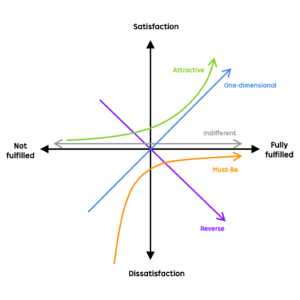The Kano Model
Episode #3 of the course Product management toolkit by Rich Headley
Welcome to lesson three. In the previous lessons, we explored the Value Proposition Canvas, which can be used to understand how what you offer can relieve pain and create value in customers’ lives. You also now have an understanding of how to develop a value hypothesis to narrow down whose pain you are trying to take away and how you’ll do it.
Today, we’ll get a bit more specific in terms of deciding what benefits / features should go into your solution, using the Kano model as our guide.
Professor Noriaki Kano developed the Kano Model in the 1980s as a theory to understand how products satisfy customers. It is broken into 5 components:
Must-Be Quality
The qualities that customers think your product must have to be worthy of them even considering using it are called must-be qualities. You can think of them as basic expectations.
For instance, when you call to make a dinner reservation at a sit-down restaurant you’ve never been to, do you bother to ask whether they have glasses to drink from? Of course not, because glasses and other dishware are a must-be quality of a typical restaurant that serves dinner.
One-Dimensional Quality
These qualities are most directly related to satisfaction or dissatisfaction. The degree to which they have a higher level of investment or effectiveness results in proportionally higher levels of satisfaction. Thus, one-dimensional qualities can also be called satisfiers.
Continuing the restaurant analogy, a place that consistently serves tastier food would most likely be more satisfying to a customer than a place that consistently serves bland or poorly prepared food.
There are, of course, other factors that make a restaurant satisfactory or otherwise. A sit-down restaurant that has dishware for you to use (a must-be quality) and delicious food for you to eat (a one-dimensional quality) is still not guaranteed to offer a fully satisfactory experience.
Attractive Quality
Just having all of the basic expectations and one-dimensional qualities covered is often not enough to make a successful product. You also need to sprinkle in some attractive qualities, often referred to as delighters, that your customer will not always expect to be there. These cost more for you to make available but can often have a tremendous impact on your profitability.
If you’ve ever watched Chef’s Table on Netflix, you’ll know that most of the featured restaurants are so successful because they constantly introduce delightful twists on preparation or presentation of traditional dishes, which is why Michelin-star restaurants can charge hundreds of dollars per person for a meal.
Indifferent Quality
Sometimes, your product will have some qualities built in that the customer doesn’t even notice or care about while purchasing or consuming. You should avoid spending too much time or money on these qualities because they don’t improve or detract from customer satisfaction.
For instance, restaurants don’t need to purchase top-of-the-line ceramic-coated saucepans if they can get reliable stainless steel ones for much cheaper with minimal effect on the food preparation. The customer will not know (or care) what was used in the back kitchen.
Reverse Quality
Often in product management, less is more. Simplicity in design, presentation, or use often results in satisfaction. Something that has so many features / benefits baked into it may confuse or discourage the customer because they were looking for something simpler. In these cases, the presence of a certain quality causes dissatisfaction, whereas the absence of it causes satisfaction.
Again with our restaurant example, using strong cleaning solutions every time a table is cleared (resulting in an overpowering chemical odor when the next party is seated) could cause a level of satisfaction that would not be present if a damp towel was used without cleaning solution.
A key aspect of the Kano model is that the further you invest into certain qualities, the more they increase satisfaction exponentially (these are delighters), the more they increase satisfaction linearly (the satisfiers), or the more they increase satisfaction logarithmically (the basic expectations). If you’re scratching your head trying to remember what logarithmically means, imagine climbing a hill that is steep at the beginning but ever so slowly levels off toward the distance, never quite getting flat.
So the point here is that you don’t have to invest much in delighters—you just need to invest in a small amount of unexpected or unusual joy bundled into your product to dramatically increase satisfaction. The more you invest in satisfiers, generally the happier your customers will be, and you need some basic expectations in there to achieve a minimally acceptable amount of satisfaction. But don’t overinvest there because your marginal returns will be lower. No one at your restaurant needs to drink out of gold-plated goblets—they just need a clean glass for their beverage.
So that’s the Kano model. It’s one of the most useful tools I’ve come across in my product management career, and it’ll help you make sure you have a well-balanced product that will keep customers coming back for more.
Next time, we’ll learn how to make your product not only satisfying but also addictive (in a good way, of course).
Recommended reading
Share with friends


